Best Label Maker For Home
There is an inherent difference between “The Best Label Maker” and “The Best Label Maker For Home”. The “best” has multiple features and is used in industrial applications. But you don’t need to apply bar codes and QR codes around the house. You just need to slap a label on something for general organization.
Before I retired, I used label makers extensively in my profession. My main use was for marking wires. Sometimes I would slap a label across an access door on the equipment I worked on. It wouldn’t keep anyone out of that access but it would let me know if someone had been inside that access door. Anyway, I have since moved on from wire marking multi-million dollar pieces of equipment to using label makers to my advantage around the house. Label makers can make your home life easier and more productive. Generally, your requirements for a home label maker are going to be much more simplistic.
Let’s look at and compare a few label makers for general home labeling requirements, shall we?
Brands
If you do deep searches for label makers, especially on Amazon or AliExpress you’ll find a bunch label maker brands out there. Probably many that you’ve never heard of. Considering that almost every label maker out there uses proprietary tape cartridges it may be best to stick with the more common manufacturers. I’m going to limit my search for the best label maker for home use to the following brands:
This list is not inclusive of everything that is out there by a long shot. This is probably where you should limit your search to though. Honorable mention may go to Kroy and K-Sun. However, K-Sun is owned by Epson.
Consumables
A label maker is useless without labels. A prime consideration when purchasing a label maker is the availability and cost of consumables. When you buy some label makers the manufacturer may include a free cartridge. But, you may find that cartridge has a greatly reduced length than a standard tape cartridge that you purchase additionally. This means you’ll need to buy some consumables sooner, rather than later.
Being able to buy a label maker AND consumables locally could be a big plus.
Most label printers, especially home label printers, situate the cutter fairly far back into the machine. This ultimately means that there is a measurable length of wasted label on either side of your print. Some can waste up to 1″. That’s 2″ of waste per label. If you are labelling a thousand boxes or shelves you’d probably seek out a labeler that used a bare minimum of waste for economical reasons. If you make “Happy Birthday” labels a few times a year to put on a card envelope the waste created is not nearly as important.
Dymo and Brother printers are sold in several big box stores. There are no retailers around where I live that sell Epson or NIIMBOT systems. You’ll likely have to go to the internet to find them.
No Preferences, Or Is There?
While it might seem like I’m building a case for Dymo or Brother……..I’m not necessarily. Walmart, Target, and Staples (and others) sell the label maker but finding anything other that black on white label cartridges might be difficult. And that leads you back to getting your consumables from the internet. If you print anything other than black on white you’re likely going to need to buy those supplies from the internet anyway.
Straight up I will tell you that I think Epson PX line is the way to go. Their machines have the most features and have the greatest selection of consumables to include magnetic tapes, and heat shrink tubing. Also they can print on ribbon material and have the best selection of colors and sizes.
Let’s compare some of the best label makers for home use.
Dymo Letratag 100H
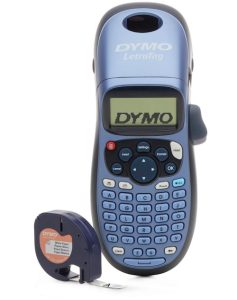
Dymo Letratag 100H
The Dymo Letratag 100H is a pretty popular label maker that can be found at most big box stores. It seems to retail around $30 but the buyer should be forewarned that it does not come with any labels or batteries.
A pack of labels is about $9, and the Letratag 100H uses 4 AA batteries. Batteries will probably add another $5 or so to the total cost. We are now somewhere in the $45 range to get started. There is no AC adapter port so this labeler will only work on batteries.
Target has a $5 discount and I noticed that I had almost $9 in Target bonus cash so I got the printer and a couple of cartridges for about $26 which isn’t too bad.
Print resolution is 160 dpi which is on the low end of most label printers. Max label size is 1/2″ which is good enough for shelf and pantry labeling and general organization to include file folders. Consumables can be bought in the big box stores but when i bought mine all that was available in store were black on clear, and black on white labels. Nothing fancy or fun.
Cartridge System
If you ever decide to upgrade to a bigger printer and jump up to the Dymo Label Manager line just know that they use a different cartridge system (D1). There is no cross compatibility between Letratag and the rest of their label maker offerings. The Dymo Letratag 100H is simple, basic, and good for general organization. Call me silly but I think if you buy a label maker you should get a power source and at least 1 pack of labels to get you started.
In hand, it feels a little awkward and has kind of a plastic-ey feeling. Despite having 160 dpi resolution the labels printed are crisp and uniform in appearance. Waste on the ends is surprisingly minimal at just over 3/8″ (10mm).
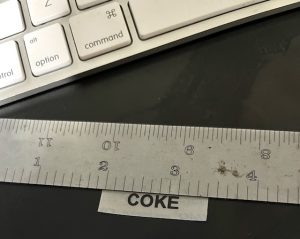
10 mm waste
By the way, my dogs name is Cocoa and we call him Coke. All test labels are “Coke”.
This is a decent label maker, at a budget price, for general organization.
John’s Tech Blog Rating
★★★☆☆
Brother P-touch, PTD210
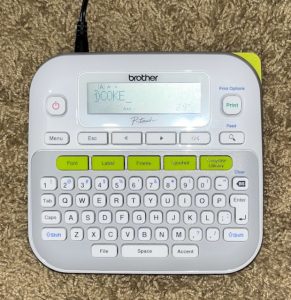
Brother PTD210
I’ve owned this for a few years and it still seems to be available on the P-touch website. it clocks in around $60. It requires 6 AAA batteries which are not included. An AC adapter is available for purchase for about $23. Seems to be a common thread with the lower end label makers that they still require additional purchases to make them work.
The PTD210 does come with a starter pack of TZe label cartridges. TZe cartridges can generally be purchased locally at office supply stores or big box stores. The TZe system is used in a lot of Brother printers that are high end. If you intend to upgrade someday you won’t be throwing away or giving away expensive cartridges.
Print resolution is 180 dpi and max label size is 1/2″.
PTD220 Option
It should be noted that you can buy a similar printer, the PTD2200 for about $40. The 220 apparently has more symbols and print options. Either printer would be a good choice for best home label maker but the PTD220 will save you a few dollars. This is particularly important when you consider that you are going to have to buy batteries and possibly an AC adapter.
I don’t have the PTD220 but if I were shopping for a Brother label maker I’d pick up the 220 over the 210 for no other reason than to be economical.
The PTD210 has pretty atrocious label waste at just barely over 1″ on either side of the printed label. This could get expensive quick if you make lots of labels.
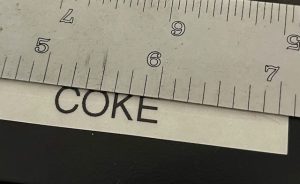
Wasted Label
The PTD210 does not have the capability to do heat shrink tubing or print on ribbon material. You are pretty much limited to what I’d call regular type labels.
While this labeler costs more than the Dymo Letratag 100H it has more options and is more intuitive to use. But, it creates a ton of waste label.
John’s Tech Blog Rating
★★★☆☆
EPSON LW-PX300
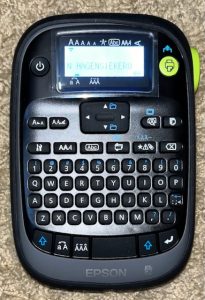
Epson LW-PX300
I’ll get straight to the point. If you do ANYTHING besides general labeling such as on boxes or file folders, the Epson LW-PX300 is the best label maker for home use. Why? Because it has way more capabilities than the previous labelers I have mentioned. There are lots more color options. Maximum label width jumps up to 3/4″ versus 1/2″ for all the other label makers I am reviewing here. Additionally, the LW-PX300 can print on ribbon. Printing on ribbon expands your craftiness foo by leaps and bounds. And it creates a very special personalized touch for cards and gifts.
Technically, though on the Epson website the LW-PX300 is listed under the “Work Printers” section. That doesn’t stop it from being an excellent and inexpensive choice for home use.
The Epson can print on smaller sized heat shrink tubing (1/8″, 3/16″). Additionally, it prints on magnetic tape. That can be fun for making refrigerator magnets or labeling on steel tool boxes.
The LW-PX300 is also in about the $60 range for just the labeler. They have a proper LW-PX300VP kit which has a hard case, a protective rubber sleeve, and an AC adapter. That kit will set you back about $90. I am a huge proponent of having a hard case and accessories. That just ups your game all that much more.
Print resolution is 180 dpi. And it requires 6 AA batteries or can run on the AC adapter.
Label waste is at a minimum around 10mm similar to the Dymo Letratag 100H.
If you want the flexibility to do a little bit more than simple labeling then the Epson LW-PX300 is your best label maker for home use. The LW-PX300 is only missing a couple features that much higher end Epson label makers have.
I almost forgot to mention that Epson label makers have a LIFETIME WARRANTY.
John’s Tech Blog Rating
★★★★★
NIIMBOT D110
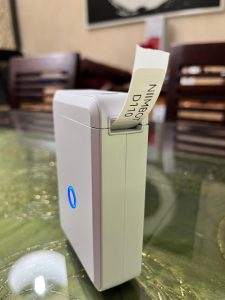
NIIMBOT D110
I found out about NIIMBOT earlier in the year and have since become a fan boy. The NIIMBOT D110 checks in around $17.99 and comes with a roll of tape. The D110 also has an internal battery which can be charged via USB.
This means that for your $18 investment you are ready to print. Max label size is 1/2″ and print resolution is a respectable 203 dpi. Connectivity is via BlueTooth.
The printer is controlled via an iPhone or Android app however, I found the app also works on Mac OS even though it isn’t advertised as doing so. The app is pretty powerful and you can import images and do all kinds of other fancy tricks.
If your intent is to just zip off general labels for organization and 1/2″ width fits your needs this is probably your best, and most economical choice. You’ll have to buy your tape cartridges online as I haven’t seen them sold in any big box stores. They also have colored tapes, cable wraps, and seasonal label rolls. Additionally, there are die cut, round labels as well.
The size of this label maker is just right as well. I carry mine in a tool bag that travels with me pretty much everywhere. It is small and unobtrusive, and always there when you need it. I think even if you buy one of the other “Best Label Maker For Home” recommendations that you should pick up one of these highly portable NIIMBOT label makers as well. You won’t be sorry.
John’s Tech Blog Rating
★★★★★
Conclusions
Just remember that there is a huge divide between The Best Label Maker and The Best Label Maker For Home. I’ve only touched on 4 manufacturers and 4 different machines. I’ve run the gamut between maximum economy and maximum usability. I own all these machines and all of them are adequate for various home usage.
That being said I still think the Epson LW-PX300 earns the title of “Best For Home”. It can do things none of the other label makers can and it is hard to beat that Lifetime Warranty. Even if you break the machine, Epson will replace it. It may be on the higher end of the price range for a home label maker, but trust me, you won’t be disappointed.
But if you all do is label file folders and pantry items with generic black lettering on a white background, then any one of these machines are more than up to the task.
Epilogue
We have hanging lights in the kitchen. I recently bought new LED bulbs for them and they were a bright white that my wife couldn’t stand. She had me get some Soft White bulbs and of course we kept the harsh ones for backup. She put the old bulbs in the new box and labelled “NOT SOFT WHITE” on the box.
Silly little label applications like that help make your life easier. Especially, in a year or two from now when you are looking through the cabinet and stumble across the light bulbs you completely forgot about. Label Makers Rule!

Should really make it more clear that the Niimbot only prints discrete labels of fixed size, not continuous tape like other labelers, so you have to purchase the specific sizes you want to print and swap out the cartridges if you want to print something longer, or want to reduce waste when printing something smaller, or to make cable labels. That really puts it in a different class from the others.
Should also compare the cost of the label cartridges. Brother cartridges are nearly half the price of Epson, but Brother labelers all waste so much tape that it could even out if you’re only printing short labels. But the LetraTag tape is 33% cheaper than the Brother cartridges per foot AND it wastes the least amount of tape per label, so the savings would be significant if you print a lot. (Just comparing basic plastic/laminate black on white cartridges.)
Just wanted to say thanks for this overview!
Your blog has been hugely helpful in identifying which label maker will work best for my needs (PX300). I also appreciate the tip from another post on purchasing used/possibly nonworking machine bundles to score OEM tapes at a good price.
I suggest setting up affiliate links for passive income. I appreciated this blog so much that I actually came back when I was ready to purchase–months later–just to make sure I clicked from here, only to realize that the product links are not affiliate links.
Thanks, your post made my day! I love the PX300. It’s not fast like an industrial printer but will serve you well.
You forgot to mention if anyof the reviewed machines require a mothly subscription fee.
I do know that the D110 requiires a $17 weekly (????) or monthly fee to use the machine.
Mine’s in the drawer because I refuse to pay the fee
This is what I found now in internet doing a quick search
No, the Niimbot D110 label printer does not require any monthly subscription fee.
Here’s a quick breakdown:
✅ Free App: The Niimbot app used to operate the printer is free to download and use. It includes over 400+ templates, fonts, and languages.
❌ No Ink Needed: The printer uses thermal printing technology, so you don’t need to buy ink or toner.
❌ No Mandatory Account: You can skip account registration if you prefer. Creating an account only helps save your custom templates.
⚠️ Ignore Ads: If the app shows any prompts asking for payment, those are ads from the app center and can be ignored.
So once you buy the printer and label tape, you’re good to go — no recurring fees required.